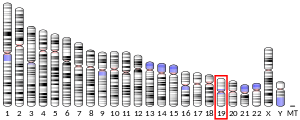KCNA7
Potassium voltage-gated channel subfamily A member 7 also known as Kv1.7 is a protein that in humans is encoded by the KCNA7 gene.[4][4] The protein encoded by this gene is a voltage-gated potassium channel subunit. It may contribute to the cardiac transient outward potassium current (Ito1), the main contributing current to the repolarizing phase 1 of the cardiac action potential.[5]
| KCNA7 | |||||||||||||||||||||||||
|---|---|---|---|---|---|---|---|---|---|---|---|---|---|---|---|---|---|---|---|---|---|---|---|---|---|
| Identifiers | |||||||||||||||||||||||||
| Aliases | KCNA7, HAK6, KV1.7, potassium voltage-gated channel subfamily A member 7 | ||||||||||||||||||||||||
| External IDs | OMIM: 176268 MGI: 96664 HomoloGene: 7791 GeneCards: KCNA7 | ||||||||||||||||||||||||
| |||||||||||||||||||||||||
| Orthologs | |||||||||||||||||||||||||
| Species | Human | Mouse | |||||||||||||||||||||||
| Entrez | |||||||||||||||||||||||||
| Ensembl |
| ||||||||||||||||||||||||
| UniProt | |||||||||||||||||||||||||
| RefSeq (mRNA) | |||||||||||||||||||||||||
| RefSeq (protein) | |||||||||||||||||||||||||
| Location (UCSC) | Chr 19: 49.07 – 49.07 Mb | n/a | |||||||||||||||||||||||
| PubMed search | [2] | [3] | |||||||||||||||||||||||
| Wikidata | |||||||||||||||||||||||||
| |||||||||||||||||||||||||
References
- GRCh38: Ensembl release 89: ENSG00000104848 - Ensembl, May 2017
- "Human PubMed Reference:". National Center for Biotechnology Information, U.S. National Library of Medicine.
- "Mouse PubMed Reference:". National Center for Biotechnology Information, U.S. National Library of Medicine.
- Gutman GA, Chandy KG, Grissmer S, Lazdunski M, McKinnon D, Pardo LA, Robertson GA, Rudy B, Sanguinetti MC, Stuhmer W, Wang X (Dec 2005). "International Union of Pharmacology. LIII. Nomenclature and molecular relationships of voltage-gated potassium channels". Pharmacol Rev. 57 (4): 473–508. doi:10.1124/pr.57.4.10. PMID 16382104.
- Oudit GY, Kassiri Z, Sah R, Ramirez RJ, Zobel C, Backx PH (May 2001). "The molecular physiology of the cardiac transient outward potassium current (I(to)) in normal and diseased myocardium". J. Mol. Cell. Cardiol. 33 (5): 851–72. doi:10.1006/jmcc.2001.1376. PMID 11343410.
Further reading
- Kashuba VI, Kvasha SM, Protopopov AI, et al. (2001). "Initial isolation and analysis of the human Kv1.7 (KCNA7) gene, a member of the voltage-gated potassium channel gene family". Gene. 268 (1–2): 115–22. doi:10.1016/S0378-1119(01)00423-1. PMID 11368907.
- Kalman K, Nguyen A, Tseng-Crank J, et al. (1998). "Genomic organization, chromosomal localization, tissue distribution, and biophysical characterization of a novel mammalian Shaker-related voltage-gated potassium channel, Kv1.7". J. Biol. Chem. 273 (10): 5851–7. doi:10.1074/jbc.273.10.5851. PMID 9488722.
- Ding Q, Zhao YY, Dong LY, et al. (2003). "[Distribution and significance of cSNP in KCNA7 gene as a novel NIDDM candidate gene in the population of northeast China]". Yi Chuan. 25 (2): 129–32. PMID 15639836.
- Bardien-Kruger S, Wulff H, Arieff Z, et al. (2002). "Characterisation of the human voltage-gated potassium channel gene, KCNA7, a candidate gene for inherited cardiac disorders, and its exclusion as cause of progressive familial heart block I (PFHBI)". Eur. J. Hum. Genet. 10 (1): 36–43. doi:10.1038/sj.ejhg.5200739. PMID 11896454.
External links
- Kv1.7+Potassium+Channel at the US National Library of Medicine Medical Subject Headings (MeSH)
- KCNA7+protein,+human at the US National Library of Medicine Medical Subject Headings (MeSH)
This article is issued from Wikipedia. The text is licensed under Creative Commons - Attribution - Sharealike. Additional terms may apply for the media files.

